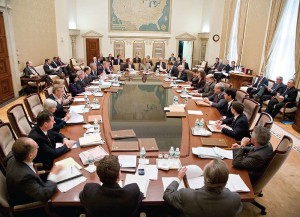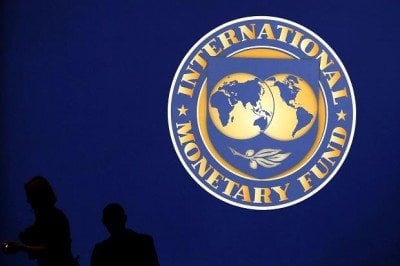![By Federalreserve (00491) [Public domain], via Wikimedia Commons](http://thegreatrecession.info/blog/wp-content/uploads/US-Federal-Reserve-Eccles-Building-1937-500x378.jpg)
Take for example this one:
Federal Reserve Economic Stimulus Plan I
I would summarize all of the Federal Reserve’s past economic stimulus plans as follows: The best way to solve a housing market crisis that comes from too many bad loans that were made due to lax credit terms is to keep credit terms fairly loose, make sure housing prices stay inflated to where no one can afford a house without those loose terms, lower interest rates down to zero, and then give banks trillions of free dollars to loan to people who are already up to their ear holes in debt, but allow the banks, if they wish, to invest that money in stocks, instead. (This is the plan I formerly called “Goliath.” Shove the debt accelerator all the way through the floor while steering hard toward the bank vault.)
Somehow, Ben Burn-the-banky and his Fed friends imagined that would work. Nobody knows why, but you can only blame them for trying. All they got was a pile-up of money in the bank vaults.
Federal Reserve Economic Stimulus Plan II
Unfortunately for the Federal Reserve, Economic Stimulus Plan I failed because no citizens wanted the extra debt because they were already drowning in debt. They couldn’t hear the Fed’s enticements to spend because the debt was over their ears. So, the board members of the Federal Reserve looked around and said, “What else can we do?”
“Hmm,” they said, “Europe has tried negative interest rates, and it hasn’t worked well for them. Maybe we should try that. Japan and China have decided to do the same. This is another idea that has been tried and failed. We don’t want to be caught with our skirt up here as the only nation that didn’t try it, so we had better explore this.”
Now, when you know that the Federal Reserve has been down at zero interest as the basis for banks to borrow money that the are supposed to loan out to you, you might think that negative interest would mean that the Fed has decided it is going to pay banks to take the money the Fed wants to loan. If that were the case, maybe the banks could pay you a little to take a loan, too. With that kind of negative interest, you would take out a loan for $100,000, and the bank would only require you pay $98,000 back. We would all, of course, take infinite loans to maximize our profits.
A plan like that might make you happy, but the Federal Reserve has figured out a more ominous form of negative interest. Free money for everyone would certainly juice the economy. (Not that free money stands a popsicle’s chance in the desert of trickling down out of a banker’s hand.) Unfortunately, the Fed banksters don’t mean the kind of negative interest where they pay you to take a loan, rather than charge you. (That would be true negative interest.)
The central bankers are not scheming to give you negative interest on the loan you take out in order to entice you to take one. What they are looking at doing is charging you negative interest on the money you keep in the bank. (Negative interest is newspeak for “positive fees” that apply now to savings, not to loan rates. It’s only negative interest from their perspective in which banks used to pay you interest on your money, but now you will pay them a storage fee for inconveniencing them.)
It starts with the Federal Reserve’s approach to its member banks. The Fed, instead of paying banks interest for the money they keep in reserve accounts, will now charge them interest on that money in hopes that the banks will pass this along by charging you interest on the money you keep in deposit. While profits rarely trickle down, costs almost always do.
That way, you won’t want to keep any more money in the bank than you have to. The Fed’s goal is to wring the very last pennies out of the bank and get them into circulation — but not the bank’s pennies so much as yours. You see, the Fed gives banks money in hope that they will loan it out to get it in circulation; but the banks have said, “No, its easy money; we’d rather just hang on to it. So, the Fed wants to stimulate the banks into circulating this money now, by starting to slowly take it away from them if they don’t. Naturally, the banks will be inclined to pass that expense on to you if they can, and the Fed wants that, too, because really it hates savers. Savers do not participate fully in the debt-based scheme of our monetary system.
Banks, you see, no longer consider it a privilege to hold your money. While that was going out of style even before the Great Recession, it became increasingly a burden to have to take your money when the Federal Reserve was giving away money in far greater amounts. It wasted processing time on trivial sums compared to the huge flow of money the Fed was depositing for free.
Moreover, it was also a burden to loan you money when banks were now allowed to play the stock market where they could make a lot more a lot faster than your pokey little 4% interest housing loan would ever make for them. In fact, they flush those loans out of the system as fast as they can by shoving them off to some other Fascist (government-private) enterprise called Fannie Mae, who pays the banks for these miserable loans, which the Federal government agrees to insure with bailouts in case the paltry loans fail. Banks want nothing to do with them unless they provide easy pass-through revenue because they can quickly wholesale them to Fannie and her husband Freddie Mac. (We won’t even get into his adulterous affairs with government officials.)
Now, if you’re aware of the fact that the Federal Reserve has required banks to build up larger reserves in order to be more solvent in a crisis, this may all seem counter-intuitive. You may naturally ask, “Why would the Federal Reserve want the banks to lower their reserves? What if there is another crisis and a run on the bank and the bank needs those reserves to pay depositors on demand.”
Well, you see, the problem there is that you ask too many reasonable questions, for which the Fed has no reasonable answers. We’re now entering the Epocalypse, and it’s time to wring that money out of the banks; but more importantly out of you. There is not even any point in trying to think of a reasonable explanation for why the Fed would want to flush as much money out of the banks as it can now that we are entering theTwilight Zone of a crashing global economy.
I know I’m not going to bruise my brain trying to figure out why this makes sense just to help others avoid the pain. However, one easy answer comes to the top of my head, which is that, until you spend all the money you have in the bank, you’re not going to take out any more loans, and our monetary system is constructed around the principal that the only way the Federal Reserve gets money into the system is by making loans. It’s a debt-based financial system. It reached the end of its expansion programs when you no longer wanted any more loans, even if they were cheap because you had enough, thanks.
You see, you’ve been a good person — or thought you were — and have been saving for a rainy day. Janet Yellen and her friends at the Federal Reserve believe you should be punished for that. You’re gumming up the mechanism by which they get money flowing into the economy. The Fed’s mojo isn’t flowing because of you!
Even though almost none of the trillions of dollars Yellen & Co. have manufactured have gone into your hands because they all went into stocks and bonds owned largely by banksters, it’s still your fault as far as the Fed’s concerned. It’s important to get you — the “consumer” — to loosen up in order to get a little velocity going as money starts to move through the system.
“Consumer” is a word for “citizen” or “person” that I don’t particularly like because it sounds like your only value is how much you eat and how much real estate you take up. That, of course, is your only value to the Fed, wherein the idea is that the more you eat, the more real estate you will take up. You’ll need a bigger bed and a bigger car and a bigger house, more seats on the plane etc. Your value to your country increases the more rotund you get. But it all only works so long as you are stuffing down Tinkies and Tauruses. They need to get you Fed up.
As it turns out, Federal Reserve Economic Stimulus Plan I failed because you, the “consumer,” didn’t cooperate. Simpleton that you are, you acted in a manner considered prudent by ordinary citizens in times like these. The main thing you need to know is that the Fed’s plan didn’t fail because the Federal Reserve is wrong or because a debt-based monetary system is a totally screwed-up idea in the first place. It failed because you don’t eat enough.
Creature from Jekyll Island: A Second Look at the Federal Reserve. “Reads like a detective story. You’ll never trust a politician again – or a banker.”
US Federal Reserve Economic Stimulus Plan being tested
At this point, Federal Reserve Economic Stimulus Plan II is just an emergency plan. They haven’t taken it off the shelf yet; however, now that they see how the world is going after the first plan failed, they want to get it ready. So, for right now, the Fed is just testing the systems to see if it will fly. It has ordered national banks (those banks that participate in the Federal Reserve System) to run stress tests to see what will happen to the banks if these negative interest rates were applied. (They don’t care at all what will happen to you; but since the banks actually do own the Federal Reserve as shareholders in its twelve member reserve banks, they want to make sure the grid can handle this reverse flow of money before they throw the switch.)
As interest rates turn negative around the world, the Federal Reserve is asking banks to consider the possibility of the same happening in the U.S…. “The severely adverse scenario is characterized by a severe global recession, accompanied by a period of heightened corporate financial stress and negative yields for short-term U.S. Treasury securities,” the central bank said in announcing the stress tests last week. (Bloomberg)
The banks are asked to test what will happen if interest rates remain negative through the first quarter of 2019. So, they are assuming a fairly long crash here.
The way this works is that the government, instead of paying interest on the US bonds it issues, will charge the banks interest. Don’t be too stressed out by the idea that this will be passed down to you anytime soon:
Fed officials have made clear that they are a long way from contemplating a reduction in rates below zero in their benchmark overnight policy rate.
How far off is “a long way.” Well, if we look for an example, Japanese officials made clear that they would never switch to negative interest rates … and then a week later they did it and only told people after the decision was made, shocking the world. If you can’t trust your banker, who can you trust? So, if “never” means about a week away, I would think “a long way” could be somewhere short of a week.
The Federal Reserve did not try this kind of economic stimulus plan coming out of the first dip of the Great Recession (which we are re-entering) because it considered it too dangerous and likely to cause major disruptions in money markets; but apparently they sense I may be right and that the second dip of the Great Recession could turn out to be the global Epocalypse. Thinking that there is an off chance that I could be right, they’re testing out the fire hoses and safety harnesses now.
Always best to be prepared in case Knave Dave knows what he’s talking about.
European Central Bank and the central banks of Switzerland, Sweden and Denmark have nudged some official lending rates negative without such repercussions, and Fed officials have publicly taken note.
It hasn’t created a catastrophe in Europe, they note (Of course,it also hasn’t worked. Europe is still in as much trouble as we are … maybe more.) The repercussions haven’t happened because banks have not passed along the fees on their reserves to “consumers,” i.e. “eating machines.” Of course, the only reason banks haven’t passed this cost along is that they are so afraid of the repercussions, which are that the “eating machines” will just take their money out of the bank in the form of cash, go on a hunger strike and sit on it. Thats why banks in Sweden and other parts of Europe are now strongly petitioning their governments to switch to being cashless societies so that there is no cash alternative to keeping your money in the bank Once the alternative is gone, the banks can turn on the fees.
Remember that the Fed has said this stress test of Economic Stimulus Plann II doesn’t mean they actually intend to do it. They will only do it if things get really, really bad. And, though I am saying things will get and are getting really, really bad, the Fed still borders on believing in its recovery. (Or some would say it tries to appear to.) To me, that delusion popped in December, so you can see this test as working out the bugs for an eventual roll-out.
Or as the president of the New York Federal Reserve Bank said,
“I suppose if the economy were to unexpectedly weaken dramatically, and we decided that we needed to use a full array of monetary policy tools to provide stimulus, it’s something that we would contemplate as a potential action.”
Lot of softeners added to that laundry list of caveats. Said another Fed official, more mater-of-factly:
Everybody is looking at how this works.
I’m sure they are. Everybody.
Secrets of the Temple: How the Federal Reserve Runs the Country. “In this penetrating study of the Federal Reserve Board in the Reagan era, Rolling Stone writer Greider views the “Fed” chairman as the “second most powerful” officer of government, the high priest of a temple as mysterious as money itself, its processes unknown to the public and yet to be fully understood by any modern president.”
So, how will the next Federal Reserve Economic Stimulus Plan work?

Federal Open Market Committee Meeting of the US Federal Reserve
- Why would banks acquire US bonds they have to pay to hold?
- Why wouldn’t you just take your money out of the bank if the banks tried to pass that cost on to you?
Not to worry. Problem number one has already been solved, and the Federal Reserve is already working to board up the exit doors in case you wish to use them.
#1) This is where the story really gets dark and deceptive and oh-so-eerily fun. You might think that banks and other investors would only pay to hold US treasuries after we are so deep into the Epocalypse that no other investment looks safe. Then banks and other financial institutions will beg to give their money to the US government to hold and gladly pay for the privilege just to make sure they don’t lose all of it.
The Federal Reserve and its partners in government, however, are not content to leave their novelties up to chance. What if their elaborate plan to entirely collapse the global economic system fails? (Or, if you’re not terribly into conspiracy theories, as I actually am not, what if they once believed that Federal Reserve Economic Stimulus Plan I was truly working and now they are seriously doubting that it is, so they preparing for the worst-case scenario?)
You see, I’m inclined to believe that all of the board and committee members of the Federal Reserve actually think they are brilliant and that they are necessary, but they are really bovine at best. Mostly, you see, I just find it far more fun to ridicule their bloated sense of their own bullish intelligence when their best plans fall to shreds, rather than to say they are a group of Hitler clones, though the latter is not entirely off the table as far as I’m concerned. However you get there, all roads still lead to Rome on this issue just by following the facts.
Economic Stimulus Plan I required that the Federal Reserve buy a huge number of US treasures. Now they don’t know what to do with them; but what if they could get people to pay to take them?
During the collapse, the Federal government also lost most of its major financiers — particularly China and Russia, who really don’t like us very much. That has left the Fed as the buyer of last resort for US government debt; but it’s pretty well tapped out. To attract new investors, the federal government would have to up the interest on its treasuries in order to roll over its monstrous debt. That would be a total disaster.
Thus, the Federal Reserve and the federal government recently formed a tag team to solve both problems by giving the Federal Reseve much broader power over the US financial system under a new plan, apparently already made law.
It has been noted by nearly everyone (especially after the crash of the Chinese stock market) that, when banks or other financial institutions buy a lot of stocks using loans, the whole financial system becomes more perilous. This is called “margin buying.”
(If you’re not familiar with margin buying in stocks, you may need the summary provided in the link above before continuing on, but otherwise, continue your enjoyment:)
Now, here it comes: The Obama administration made deals last fall with the G-20 to give the Federal Reserve power to change the regulated amount of stock margins from 50% to whatever it deems right whenever it deems the change is necessary. Ostensibly, this was to keep the stock market from becoming too top-heavy with debt because those margin calls that the broker can make on leveraged stock purchases can be devastating during a bear market, creating a situation where many margin calls are happening at a time in which investors have to sell off assets at fire-sale prices into a falling market in order to come up with the additional cash they need for collateral. The rapid-fire sales that come when multiple parties reach their margin limits bring the value of everyone’s assets down more, which snowballs into an all-out crash.
Before the stock market gets so heavily bought “on margin” that it becomes perilous, the Fed can start upping the margin requirement — the level at which investors have to cough up more cash to cover their loans. Call it “cough and cover” because it hits like a market flu.
This new power to change the rules of the game on a whim creates risk uncertainty, and markets hate uncertainty, as who knows when the Fed will change what the margin can be? It could happen when you are least prepared to cough and cover.
To offset this uncertainty concern — and here is where it gets really colorful and fun — all investors who use US treasuries as collateral for their bets in the stock market are IMMUNE from the Federal Reserve’s new power. Their margins cannot be changed on the basis that it is assumed US bonds are the least likely collateral on earth to lose value anyway.
Now, pause … and think about the simplicity and beauty of this new architecture. I think you can be certain that the United States and the Federal Reserve in collusion have just created a system in which a) the US government will have many guaranteed buyers for new issues of US debt because it is the only collateral on leveraged buying that keeps the Fed’s hands off; and b) the Federal Reserve will be able to sell off the trillions of dollars of US treasuries it has purchased. But the best part of all is that the Federal government and the Federal Reserve will be able to make certain that people now pay the government to hold government bonds.
Oh, that’s sweet! Safe investments for retirement are no more. The more you save, the more you lose.
Connect the dots: Investors love, love, love to buy stocks with loans, loans, loans because they hope to use their money as a downpayment to make much more money off of other people’s money. No one loves other people’s money more than Wall Street and the banking cabal. So, if they only have to pay half a percent to give their money to government, they have locked their own money up someplace they feel safe (as their hedge on investments) and can still use the treasuries as collateral to go invest in the stock market with a loan from someone else!
Isn’t that wonderful? Let’s say you have $10,000,000 to invest. You don’t want to put all of it in stocks, so you invest half of it in US bonds. You still want to buy $1o,000,ooo worth of stocks, however, so you put your remaining $5,000,000 into a stock investment and use your $5,000,000 worth of US bonds as collateral on a loan for the other $5,000,000. Your plan is that the bonds go up in value if the stocks drop; but if the stock rise, you still made money off the bonds just by holding them.
If you think the federal government gave the Federal Reserve this new power in the stock market just to have a skilled and impartial referee in the market who can reduce the leverage in the market if they see people are going crazy with loans (as happened in the Chinese stock market), ask yourself why they would grant any provision for immunity from the plan at all … especially knowing that 95% of the market is likely to switch to using treasuries as collateral as the only thing that guarantees immunity from a sudden change in Fed policy.
In other words, granting this immunity, means everyone has a way to circumvent the Fed’s ability to curb margin buying, making the Fed’s new oversight powers almost totally ineffective, while pushing a lot of people into US treasuries. Suddenly paying half a percent to the Federal government to keep half of your money safe for you while you gamble with the other half, doesn’t look so bad.
You might think investors would just flee to other nations to avoid paying small interest in order to hold US bonds. Don’t worry, the new plan to give central banks this kind of regulatory power over national stock markets has already been made global. That’s why Obama and the other G-20 nations agreed to the plan together. (They have to have something to do when they get together, and this is one of the things they’ve been hatching. You might call it “conspiracy,” but now the more accurate thing to call it is simply law.)
#2) In case you think you’ll run for the exit, the Federal Reserve already has its best friends at Bloomberg working the populace and the politicians to end this problem. Bloomberg’s team of editors just published an article advocating that the US now become a cashless society. Yes, that idea, first predicted by radio preachers of apocalyptic prophecy back when I was just a kid sitting at my mother’s table while she made apple pies, is finally going mainstream.
(The really bad ideas digest more slowly, so it’s been nearly fifty years in the making. Even now the Fed knows it needs advocates for the plan who don’t look so long in the tooth; but the idea is rapidly becoming fact in a number of European nations and is being explored by China as well. Now that the Fed has gained the new powers described above, the war on cash is finally being taken public in the US. That’s why you’ve been hearing a lot more about other nations going this route. It’s the thing to do! It’s fashionable.)
Once societies become cashless, then banks can push the negative interest onto depositors without worrying about the ramifications because the other alternatives — gold, silver, jewels and collectibles — are not easily tradable unless you turn them back into cash. Not too many car dealers will give you a car in exchange for three fine diamonds. Not too many grocers will give you a cart full of produce in exchange for a roll of copper wire. With all of those things you pretty much have to trade them back into the bank’s cashless money in order to buy and sell.
So, you cannot just get out of the system. You’ll be stuck with their fees, which will be nominal, of course. For the first year. You see, your cash is no longer a burden to the banksters if you start paying them interest to hold it for you.
You are entering the Twilight Zone … otherwise know as the Epocalypse. If you thought Wonderland was a strange place — that upside-down world where bad news was good news for Wall Street — wait until you see the gravity-free realm of negative interest rates in which the banks go kaching! every time you look at your money. Excuse me, every time you look at your credits.













